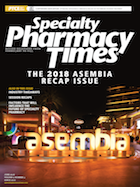Specialty Pharmacy and Diabetic Retinopathy
Specialty pharmacists play a key role in guiding the treatment of patients with diabetic retinopathy.
Specialty pharmacists play a key role in guiding the treatment of patients with diabetic retinopathy (DR), according to a continuing education symposium presented at the Asembia Specialty Pharmacy Summit 2018.
DR is a microvascular complication of diabetes mellitus, and its incidence is associated with poor glycemic control and hyperlipidemia. The symposium provided a comprehensive overview of the specialty pharmacist’s role in the management of DR and diabetic macular edema (DME), including treatment administration, adverse effect profiles, potential drug interactions, and the efficacy of pharmacological agents used in the treatment of eye disorders.
Additionally, clinical trial data and best practices in patient and physician communication were covered. The presentation began with an overview of epidemiological data and the pathophysiology of DR, followed by a review of DR-related symptoms, diagnostic criteria, and burden of disease. Next, the presentation covered an in-depth review of treatment options and recommendations. The goals of treatment are to address vision loss, maintain treatment adherence, and minimize adverse effects and reactions.
Treatment options include laser photocoagulation, anti—vascular endothelial growth factor (VEGF) drugs, corticosteroid injections, and vitrectomy. Protocol T was a comparative efficacy trial of aflibercept (2 mg), bevacizumab (1.25 mg), or ranibizumab (0.3 mg) for center-involved DME on vision impairment. After 1 year, all agents improved visual acuity; however, compared with worse baseline vision, aflibercept was more effective than bevacizumab and ranibizumab. After 2 years of therapy, there was no statistical difference among the 3 agents in terms of adverse events or visual acuity improvement; however, bevacizumab was less effective than aflibercept in patients with worse baseline vision.
Notably, the RIDE and RISE trials established the efficacy and safety of ranibizumab with substantially reduced injection frequency, averaging only 4.5 injections over an average follow-up of 14.1 months. Vision gains seen initially with monthly injections were maintained at 36 months. Ranibizumab is the only FDA-approved therapy for DR and can be used in patients with or without DME. Adverse effects seen with ranibizumab include eye pain, increased intraocular pressure, conjunctival hemorrhage, and vitreous floaters.
More severe adverse effects include endophthalmitis (≤1%), retinal detachment (1.0%- 10.0%), and arterial thromboembolic events (≤10.8%). In addition to ranibizumab, bevacizumab may be compounded and used off-label for DR therapy. However, bevacizumab is difficult to compound correctly, with 81% of samples from 11 pharmacies demonstrating lower protein concentrations compared with bevacizumab acquired directly from the manufacturer.
Following a review of these agents, the sym- posium covered emerging therapies and cost-effective considerations for anti-VEGF therapy. The presentation concluded with a review of the role of the specialty pharmacist in DR/DME care, including identifying at-risk patients with diabetes, encouraging eye exams and treatment adherence, educating patients, providing assistance with cost of care, applying preventive strategies, and evaluating treatment and adherence.

